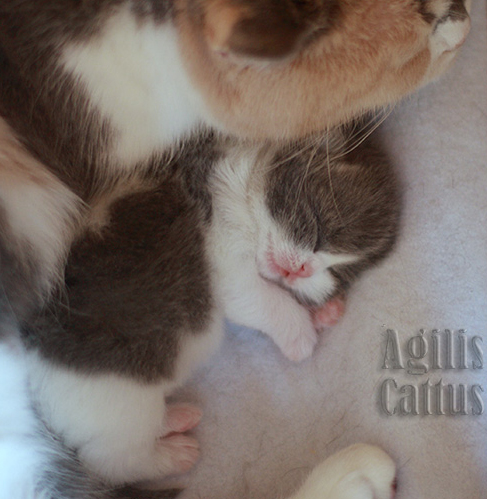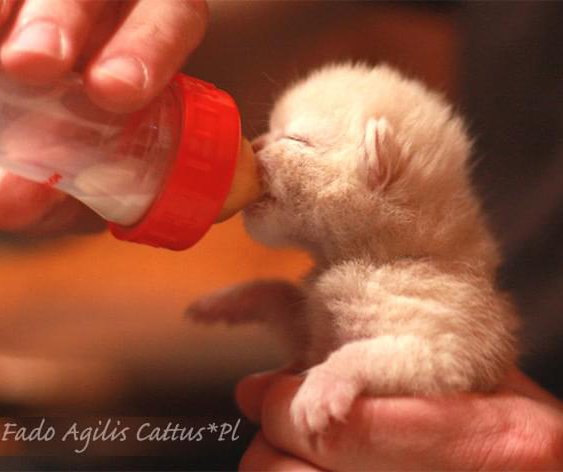At what age do we separate a kitten from its mother, and why it is so important.

Changes in today's social structure mean that more and more people are beginning to see the cat as the ideal everyday companion. This applies not only to families with children, but also to single people who spend a lot of time away from home and want to own an animal. Unfortunately, this is not always followed by adequate preparation for creating the right conditions for the cat, knowledge of its biology and needs, or knowledge of the developmental pattern characteristic of this species. These deficiencies are the most common cause of behavioural problems in adult cats, and many feline behavioural issues have their roots in the cats's early life. If they haven't had the opportunity to learn the correct reactions to various stimuli in a timely manner, and have not been through the various stages of early socialisation correctly, this is reflected clearly in their adult life.
Every species has periods in its developmental pattern that we call critical periods. These are periods in which a species learns new skills most quickly and easily. These processes have their own dynamics; there are moments of acceleration, followed by a period of refinement of the skill in question. In the case of cats, the earliest and most important of the critical periods in which the kitten learns to respond correctly to new stimuli, also called the critical period of early socialisation, is between 2 and 7 weeks of age. During the critical early socialisation period, the kitten learns the correct responses to new stimuli and develops the basics of all the motor skills used in the future. This is the time when kittens learn to run, jump and climb and, in terms of emotional development, it is a period of very positive attitudes towards all novelties.
During this period of early socialisation, our kitten should, in addition to learning to behave in relation to its mother or siblings, also have the opportunity to familiarise itself with as many stimuli as possible for the future, so to speak, training its skills to respond to the 'new'. This is crucial for the cat's future reactions to situations and stimuli that will, after all, appear in his later and adult life. Of course, this is also a time of familiarisation with humans. Preferably with a human at different stages of development :) The more different stimuli a kitten encounters during early socialisation, the better emotionally prepared it will be to meet the "new" in its later life. Of course, these stimuli must not exceed the kitten's adaptive capacities, they must not frighten it, and we, as people responsible for their developmenmt, should together with the cat's mother teach that meeting the "new" does not have to be scary.
This is not, of course, the end of learning and gathering experiences, because after this period secondary socialisation begins, and this process continues throughout life, although its greatest intensity is at 8-16 weeks. It is as important as primary socialisation period. Just as the early socialisation is learning to respond to the new, gathering information about the multifacetedness and richness of the surrounding world, the period of secondary socialisation is training in social competence, both towards humans or other cats and other animals in general. It is also the period in which the kitten develops and perfects the elements of the hunting sequence. If this period is neglected, later there are not only problems with aggression resulting from improper play, undesirable behaviour such as throwing oneself at hands, calves, feet or biting hard during play, but also emotional problems resulting from deficiences in the presentation of natural behaviour patterns characteristic of the species, i.e. stereotypies, elimination outside the litter tray or self-aggressive behaviour.
As a result of such designated socialisation periods, many misconceptions have arisen as to the age at which a kitten can be taken from its mother. These are, unfortunately, still perpetuated in the commonly transmitted 'knowledge' about cats.
The age at which we can separate a kitten from its family group should be determined by the emotional maturity of the kitten and not, as is often the case, by its physical ability to take food on its own. Cats mature very quickly in this respect, with stray cats starting to learn to kill prey brought by their mother as early as six weeks of age. Those in our homes at this age are usually already able to eat solid food without problems. 6-week-old kittens already have a set of deciduous teeth and 8-week-old kittens are perfectly capable of eating a target meat diet. However, this does not mean that this is the age at which we can separate cat babies from their mothers. They should stay with their mothers up to at least 14 weeks of age, as the process of weaning is not finished at the age of 8 weeks, despite the ability to eat solid food.
Separation from the mother too soon, before the age of 14 weeks causes a number of later behavioural problems, such as aggressive behaviours, sucking cloth, distorted appetite (pica), or stereotypies, resulting from excessive timidity and lack of stress management training. It is important to remember that taking an eight-week-old or even a ten-week-old kitten is not only depriving it of contact with its mother or with other kittens. It is impossible to carry out a proper vaccination programme (a kitten should receive its first vaccination at 8 weeks, then another at 12 weeks. A single vaccination does not give the kitten any immunity. On the other hand, at 8 weeks a kitten will come to us unvaccinated at all, exposed to diseases, because the immunity obtained with the mother's milk expires at this age. Vaccinating a kitten under 8 weeks is, except in exceptional circumstances, completely ineffective). On the emotional side, the period of secondary socialisation is a time of intensive play with other kittens, learning about one's own abilities, learning what pain is when one goes too far in play, learning cat communication and the rules of coexistence with both other cats and humans. This is also the time when kittens realise that they too are inflicting pain. In fact, kittens should remain in their family group until at least 14 weeks of age, ideally until 16, the end of the most intensive phase of secondary socialisation.
Between 8 and 12 weeks of a kitten's life, one of the most important events in terms of building its future emotional stability takes place, namely weaning. Weaning is the first really traumatic, hugely stressful experience for the kitten. Unfortunately, it weaning does not look like that the kitten simply wants to suckle its mother less and less. The desire is still there, despite other food sources and often a full tummy (kittens often try to suckle after eating a lavish, meaty meal). There is humble approaching, asking and purring. During the weaning process, the mother prohibits the kittens from suckling her nipples in the first step by lying down on her belly, physically preventing them from approaching. In the next step, she begins to display agonistic behaviour towards the kittens, growling, crouching, forcing them to leave, or she herself leaves without allowing them to suckle, which is a source of great stress, frustration and disappointment for the kittens. The ability to deal with frustration and stress is precisely the most precious learning of this period.
Frustration and stress management, the types of strategies that the body takes in stressful situations is an extremely important skill that is not given to any of us in an elaborate and definitive version, we have to learn to cope with negative emotions, and kittens have to learn the same. It is from this period of the feline life that the kitten learns that "I can cope, even though my mother no longer cuddles me, I will not die, I can survive. I can take care of myself." There is also another lesson that comes from this time: even though mum looks threatening at times, even though she can hold me painfully and force me to leave, it is not the end of the world. It's learning how to recognise as quickly as possible when another cat doesn't wish to be approached. For first there is clear body language, refusal of access, aggressive behaviour on the part of the mother only occurs when the feline does not react to these first signals. If I listen - nothing happens. This teaches the kitten not to react nervously, chaotically, not to panic at the sight of something not to its liking, something not expected.

Research to date shows that some of the most fearful cats in adulthood are those that did not go through a natural weaning period at all, i.e. cats raised on a bottle. Of those reared by their mother, the later they were taken from her, the less likely they were to react aggressively in adulthood, not only towards strangers or cats, but also family members. The later they were taken from their mother, the lower the anxiety reactions to new situations in adult life as well.
The species-specific developmental pattern of the cat makes the absolute minimum age for collection/adoption of a kitten 14 weeks, the optimum is 16 weeks. 16 weeks is the age at which a kitten gains tremendous self-confidence, stops seeking its mother's protection for every new experience, and begins to decide for itself how to test and approach new stimuli and situations. Self-confidence and a sense of control over one's environment is crucial to a cat's emotional balance, making it less likely to break out into an uncontrolled panic attack at the sight of a new situation, and this in turn significantly reduces the likelihood of aggressive behaviour, which is underpinned by anxiety resulting from a lack of training in how to respond to new situations and stimuli.
I want to emphasise that we don't think about all this when we have no choice. Saving a cat's life is paramount, if it involves having to take a kitten under our roof before the minimum age, we do it no matter what. There are times when we have to replace a kitten's mother from the first moments of its life. My appeal not to pick up kittens before these minimum 14 weeks is aimed at those who have the choice of a pick-up/adoption date.
Dorota Szadurska, Cat Behaviourist Supervisor at the Centre of Applied Pet Ethology (COAPE)
Graduate in Animal Psychology at the Polish Academy of Sciences
Member of The International Association of Animal Professionals